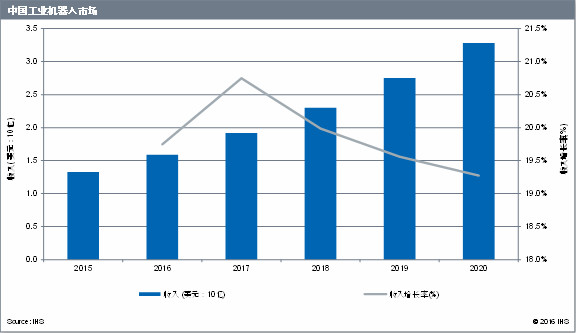-
Your current location:Home >> Industry News >> In 2015, China’s industrial robot market reached U
-
China’s manufacturing industry is characterized by overcapacity, uncertain short-term economic prospects, and weak willingness of enterprises to replace machines, which will limit the growth of industrial robot sales
According to IHS, the world’s leading market research company, the market value of China’s industrial robots reached US $1.3 billion in 2015, and will maintain a compound annual growth rate of 20%, reaching US $3.3 billion by 2020. In 2015, China’s sales revenue of industrial robots accounted for 13% of the world’s total, and will reach 25% by 2020.
Mr. mark Watson, senior manager of manufacturing technology at IHS technology, said that the manufacturing recovery will bring billions of dollars of development opportunities to the industrial robot market. Labor intensive industries are more and more inclined to automate production, especially in the Asia Pacific region where labor costs are rising rapidly. Labor shortage leads to wage increase, which reduces the potential investment income of many end users.

After 2018, with the technology optimization process of the end-user factory, the capacity utilization rate of the manufacturing industry will increase, the application rate of industrial robots will increase, and the product price will decrease. With the increasing labor cost, low commodity price, and fierce competition with other low manufacturing cost areas, the application of industrial robots will be further expanded. Under the 13th five year plan, due to direct credit and tax relief, enterprises can increase investment in robots, which is conducive to the growth of the industrial robot market.
2160421-IHS-2
However, according to the latest research of IHS’s industrial robot market intelligence service, under the condition of uncertain short-term economic expectation in China, many industries have overcapacity, especially heavy industry, which will limit the growth of industrial robot market. In this case, there is little demand for enterprises to improve productivity, so it is unlikely to install industrial robots on a large scale. Instead, they are more willing to hire temporary workers because they are more flexible and less capital intensive for local businesses. However, with the continuous transformation of China’s economy to a service-oriented economy, the problem of labor shortage will become more and more obvious.
Mr Watson believes that enterprises need production flexibility and determined production efficiency, which lays the foundation for the application of industrial robots. After using robots, enterprises can easily adjust production level and manufacturing process, save labor cost and reduce dependence on temporary workers.
In 2015, foreign brands accounted for more than 80% of China’s total industrial robot sales. These foreign brands occupy a leading position in China’s robot market. They have established cooperative relations with leading domestic manufacturers to provide high-quality software and hardware and support services.
Mr. Watson believes that the main competitors in China’s industrial robot market invest a lot of money in R & D to develop products with collaborative ability and deep learning ability, improve their artificial intelligence level and develop other emerging technologies, so as to ensure that they occupy a favorable position in the industry competition.
As a result, local suppliers in China face fierce competition for market share.




